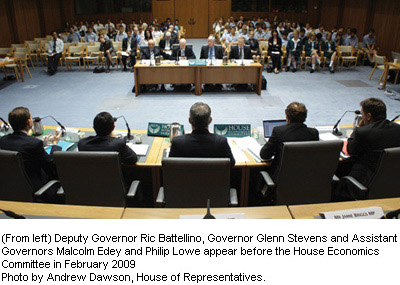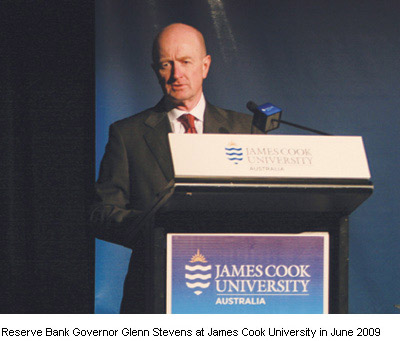Reserve Bank of Australia Annual Report – 2009 Accountability and Communication
Relationship with Government
Section 11 of the Reserve Bank Act 1959 sets out the relationship between the Government and the Reserve Bank Board. It confers substantial independence on the Board, but balances this with an obligation to inform the Government of its policies ‘from time to time’ and a requirement for Parliamentary accountability. Discussions between the Bank and the Treasurer serve to keep the Government informed.
Reporting Obligations
The Reserve Bank is a Commonwealth authority for the purposes of the Commonwealth Authorities and Companies Act 1997 (CAC Act) and, for these purposes, the members of the Reserve Bank Board are the directors of the Reserve Bank. As such, they are responsible for the preparation of the annual report. At the meeting of the Board on 4 August 2009, they resolved that the Chairman sign the annual report and financial statements as at 30 June 2009, transmit them in accordance with the requirements of the CAC Act and arrange publication.
The House of Representatives Standing Committee on Economics has, in its Standing Orders, an obligation to review the annual report of the Reserve Bank and the annual report of the Payments System Board. The Committee holds twice-yearly hearings, at which the Bank presents its views on the economy and responds publicly to questions from Committee members. In 2008/09, the Governor and senior officers attended hearings in Melbourne in September 2008 and in Canberra in February 2009. These appearances, and the quarterly Statement on Monetary Policy (see below), are important elements of the arrangements embodied in the understandings between the Governor and the Treasurer outlined in the fourth Statement on the Conduct of Monetary Policy, which was issued in December 2007 following the election of the current Government.

During the year, senior staff of the Reserve Bank also provided evidence before Federal Parliamentary committees conducting inquiries into particular matters. These included the Senate Select Committee on State Government Financial Management in July 2008 and the House of Representatives Standing Committee on Economics inquiry into competition in the banking and non-banking sectors in August 2008.
Communication
The Reserve Bank views it as important to ensure a high degree of transparency about its goals, decision-making processes and the analysis and reasons behind policy decisions. Transparency not only facilitates the accountability of an independent central bank in a democracy, it also increases the effectiveness of monetary and other policies by promoting informed decision-making by the community.
Apart from regular communication about monetary policy and decisions of the Reserve Bank Board, which were changed in 2007 in an effort to enhance the Bank's transparency and accountability, the Bank has a longstanding and extensive program of communication.

The most direct form of communication is delivery of speeches. During 2008/09, the Governor, Deputy Governor and senior officers gave around 30 on-the-record speeches on various topics, many of which encompassed aspects of the financial crisis, including its causes, consequences and policy responses. There were numerous updates on the economic conjuncture and medium-term outlook as well as consideration of longer-run economic challenges. There were explanations of developments in the payments system, thinking on macro-prudential issues and the inflation-targeting regime more generally. Audio files of these speeches, along with the Q&A sessions that follow, are now available on the Reserve Bank's website, further enhancing transparency and accountability.
The quarterly Statement on Monetary Policy informs the financial markets, media and wider community about the Reserve Bank's thinking on monetary policy and provides a basis for the Parliamentary Committee's questioning of the Bank. These statements provide an analysis of the state of the economy, the outlook for inflation and economic growth, and further explanation of recent decisions on interest rates.
The Reserve Bank Bulletin is a monthly record of media releases, speeches, monetary policy minutes and a wide range of statistics. The Bulletin also includes articles on various topics, which in the past year included commodity prices, export developments, conditions in the foreign exchange market, household wealth, ATM reforms and banking fees.
The Financial Stability Review, published in March and September each year, gives a detailed assessment of the overall condition of Australia's financial system. As well, there is analysis and views on issues of specific interest; in the past year such issues included government guarantees of deposits and wholesale funding, over-the-counter credit derivatives and Australian listed property trusts.
The Reserve Bank disseminates research conducted by the staff in the form of Research Discussion Papers (RDPs). While the views expressed in these papers are those of the authors and do not necessarily represent those of the Bank, their publication encourages discussion and comment on economic issues among a broad range of researchers. During 2008/09, 11 RDPs were released on a wide range of topics, including liquidity management, the regulation of payment systems, economic modelling and forecasting, the effects of monetary policy, currency misalignments and the term structure of bond yields. Staff have also had their work accepted in various publications, such as the Australian Economic Review, JASSA, the International Journal of Theoretical and Applied Finance, the International Statistical Review, the Economic Record, the Applied Economics Quarterly, Applied Economics Letters, the Australian Journal of Agricultural and Resource Economics and the BIS Quarterly Review.
Reserve Bank staff present their research at external conferences. In 2008/09, papers were presented at such gatherings as the Workshop of the Asian Research Network for Financial Markets and Institutions, held in Hong Kong; the Conference of Australian Economic History, at the Australian National University; a meeting of the Econometrics Society, in Wellington; the Federal Reserve Bank of Chicago's International Banking Conference; the Norges Bank's Research Conference on Payment Systems; and the Reserve Bank of New Zealand's Workshop on Nowcasting with Model Combination.
The Reserve Bank itself holds regular conferences, bringing together academics, central bankers and other economics practitioners. The 2009 conference, jointly hosted with the Australian National University's Centre for Applied Macroeconomic Analysis, was on ‘Inflation in an Era of Relative Price Shocks’. A precursor to this conference was convened in Münster, Germany, in association with the Viessmann European Research Centre and the Westfälische-Wilhelms Universität. A volume of the conference papers and discussions, the 21st in the series, will be published later this year. The Bank issued a call for papers for a Research Workshop to be held later in 2009 focusing on issues relating to financial stability and monetary policy in open economies. This follows a Research Workshop at the end of 2008, which was convened with the assistance of Professor Adrian Pagan (University of New South Wales) and Professor Fabio Canova (Universitat Pompeu Fabra). It featured 12 papers by academics and central bankers from Australia and overseas. The Bank was also host to a number of prominent invited academics through the year, who conducted research on issues relevant to monetary policy and presented seminars during their short visits.
The Reserve Bank publishes information in both electronic and hardcopy formats. Demand for hardcopy publications has been declining as use of its website continues to grow strongly. In 2008/09, the number of page views/downloads of information on the website averaged about 91,500 per day, up by 40 per cent on the previous year. The increase in usage of the website has reflected the increased appetite for economic information stemming from the global financial crisis. In September and October 2008, when the financial crisis intensified, website usage roughly doubled. On 7 October 2008, when the policy interest rate was reduced by 100 basis points, there was a ten-fold increase in visits to the website. Consistent with this increased appetite for economic news, the number of subscribers to the email service for alerts about information published on the website increased to around 15,500 at the end of June 2009, up from 13,500 at the same time the previous year.